Matador Network's Blog, page 1223
November 8, 2018
Reasons to go to Finland in winter

When winter hits northern Finland, the sun makes itself scarce. It can stay below the horizon for two months… or longer. You might wonder why anyone would go there at that time of year. In fact, Finland is a magical place in the darker months, where blankets of snow stretch as far as you can see, purple and orange sunrise hues last for hours, and lit candles decorate every window. Add classic activities like reindeer sleigh rides, skiing, and hanging with Santa Claus, and Finland is the ultimate destination for a winter holiday. If you’re a sucker for all things cozy, here’s why you need to go to Finland this winter.
The painted daytime skies and starry nights are equally cool.
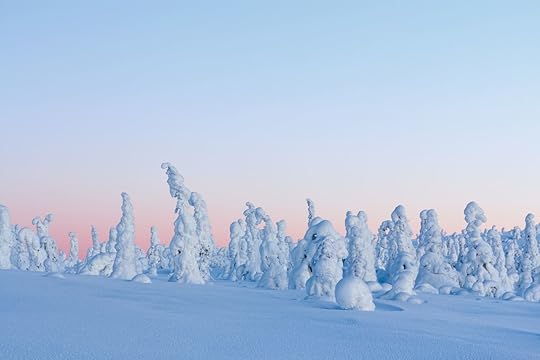
Photo: tarmofoto/Shutterstock
Ok, most of the day is actually dark. If you’re above the Arctic Circle in the northern third of the country, the late December sky will be pitch black and star-studded by 2:45 PM. You could call it night. But while the sun doesn’t crest the horizon all day, every waking hour isn’t spent in darkness. Around 9:00 AM, you’ll notice an ethereal lavender hue in the sky. That color will linger for hours since the sun isn’t actually rising — rather, it’s hanging out just below the horizon. The light that does fill the sky reflects off the white snow and illuminates everything with a pale, crystalline glow.
Finland is the home of Santa Claus.

Photo: Kiselev Andrey Valerevich/Shutterstock
Nevermind that the North Pole is 1,600 miles away. Rovaniemi is the official hometown of Santa Claus. It was declared that in 1985 back when Santa wore an earth-toned outfit and had mostly Finnish visitors. After Finland began marketing Santa’s Village more heavily a decade later, and put Santa in a red suit, visitors started arriving by the jumbo-jet load.
Although Rovaniemi’s airport is tiny, the runway is long enough to handle big planes from places like the UK and China. EasyJet offers £49 fares from London into Rovaniemi in the days before Christmas, so kids can ask Santa for their gift and make it back home to England in time for bed. Half a million tourists now visit Rovaniemi yearly.
You can take a sleigh ride pulled by a reindeer.

Photo: Roman Babakin/Shutterstock
After meeting Old Saint Nick in the Santa Claus Holiday Village, you can do traditional Nordic things like ride a sleigh pulled by reindeer or go to a reindeer farm set amidst the birch trees and see the iconic animals cared for by folks in traditional, colorful Lapland outfits. Less traditionally Finnish options that are still apt for cold weather include going on sleds pulled by huskies or taking a snowmobile tour. You can book all these through the Santa’s Village website.
Sleeping in a snow-covered cabin is as cozy as it gets.
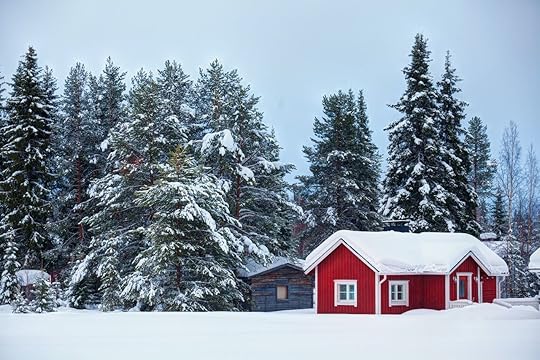
Photo: Max Topchii/Shutterstock
If Santa’s Village is not your thing, Rovaniemi — which is a one-hour flight or a northbound overnight train from Helsinki — is still a super place for a winter break. In town in December, lit white candles decorate windows, lending it a romantic, moody quality. Just outside of town, the forests and the Ounasvaara, a gently sloped mountain that overlooks the town, are cloaked in snow.
The Ounasvaara is a wooded resort area next to the Kemijoki River, a fast-moving river that somehow manages to freeze, along with everything else, in the height of winter. Alongside that river, on the lower slopes of the Ounasvaara, and even on top are multiple cabins that you can rent. Decorated in crisp Nordic style with blond wood and unfussy furnishings, the two-story cabins all have saunas, which are a great place to warm up after a day outside.
The top of the Ounasvaara is a big plateau with 120 miles of cross-country ski trails, which are well-maintained and lit. You can also snowboard, downhill ski, or even bobsled on the Ounasvaara.
You can ski in the dark.

Photo: Tsuguliev/Shutterstock
Finland doesn’t have very tall mountains — they’re more like fells, or very big hills — but it’s got powder snow to spare. One hundred miles north of Rovaniemi is the ski resort Levi, which has tall enough pistes to host World Cup championships. Snow falls on the trees and then stays frozen there until the spring thaw, so literally everything is white. The landscape is whiteness – white ground, white hills, white outlines of trees — against a pink, purple, deep blue, and then black sky.
In Levi, the chairlift takes you to the top of the resort, which is 1,742 feet above sea level. In the middle of the day, that’s just high enough to look to the horizon and see the edge of the sun, which at ground level would be fully below the horizon. The blazing colors of sunset, or maybe it’s more like sunrise, stretch out along the horizon for a couple of hours.
By mid-afternoon, you’re skiing in full-on darkness, but the runs are well lit. It’s pretty rare to ski under a black sky but be able to see the piste below you. Since everything is so well lit, lifts stay open late. You could ski until 7:00 PM if you wanted to — as long as you wear more layers than you’ve ever worn before.
Saunas were invented here.
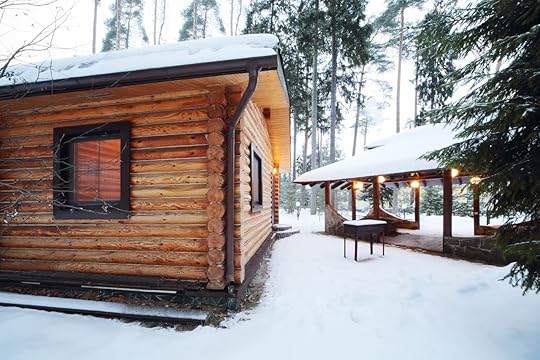
Photo: Pavel L Photo and Video/Shutterstock
Not far from Levi, at the Ylläs ski resort, in between skiing you can take a couple of hours to relax at the mountainside hot tub and actually get into a sauna on the chairlift, one of the craziest saunas in the world.
Sauna is a Finnish word, and once you come to Finland, you’ll understand their obsession with them. Finnish saunas often have space below the glass door to let in fresh air, they generally are near a lovely view — though not usually of a ski slope underneath — and they’re always near someplace where you can cool off. In winter, since the rivers and lakes are rock solid, that cold place could be the snow — ready to be rolled in. But when it’s 20 below, stepping outside might be enough.
You can freeze soap bubbles.

Photo: a_helga14/Shutterstock
Finns didn’t come up with this trick, but if you’re going to freeze your buns off in temperatures that can plunge well below -20 degrees Fahrenheit, you should have some fun with it. When you go to northern Finland in mid-winter, bring some soap bubbles with you. Wait for the coldest day in the forecast. They go outside and blow those soap bubbles. They’ll freeze before they hit the ground, or shatter in mid-air.
You can get around town the old-fashioned way.
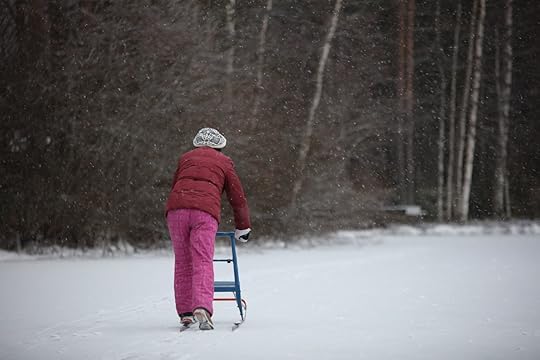
Photo: Jarhe Photography/Shutterstock
Throughout northern Finland, folks forgo snow chains and spinning tires for old-school transportation. The snow kick-sleds have two long skis with a basket or a chair on top. You put your foot on one ski while you propel yourself forward with the other foot, like a scooter. They’re easy to find in places like Levi. You can just pick one up and cruise around on paths throughout the forest, or head to the local grocer.
No one does hearty winter food and drinks better.

Photo: Mahara/Shutterstock
After saunas, Finns cope with the bitter winter temperatures with hearty food and drink. Right on the ski hill in Levi, there’s nothing like popping into a ski lodge and finding it glowing and warm inside, offering up a delicious salmon chowder, rich with chunks of salmon and potatoes, flavored with herbs, and served with a thick slab of rye bread.
Other classic winter recipes are reindeer with mashed potatoes and beet soup. Karelian pies are a savory pastry made with rice and rye flour, and pulla look like cinnamon rolls but are spiced with cardamom and a touch of sugar.
You can also warm up with a shot of salmiakkikosu, which is vodka made with salmiakki, the weirdly salty and strong licorice Finns are so addicted to they add it to vodka. As for vodka, Finns love it so much they give it to Santa Claus (or a relative in a Santa suit) when he comes to drop off presents on Christmas Eve. By the end of the night in town, drunk Santas teeter along the city streets. Drink too much salmiakkikosu and that could be you.
You’ve got the best chance of seeing the northern lights.

Photo: Sara Winter/Shutterstock
The northern lights are never a guarantee, but above the Arctic Circle, you’ve got great odds for spotting the unusual bands of lights that streak across the sky, sometimes green or purple-hued, moving like ribbons dancing to their own rhythm. We’ve all seen the movement of waves or flags swaying in the breeze. But these charged particles near the earth’s poles move in patterns you’ve never seen before… and won’t soon forget. 

More like this: The 5 most epic, unique ways to see the northern lights
The post For an unbeatable winter wonderland holiday, you need to go to Finland appeared first on Matador Network.

Best beers in college football towns

As much as college football is about winning, school pride, and rivalries, it’s also about the party. Every fall Saturday in college towns across the country, students, alumni, and fans flock to the bar to celebrate a win or forget a loss. And what people are drinking largely depends on where you are.
Upserve, a restaurant management platform, gathered data from thousands of restaurants in the US to see which beer is the most popular in big college football towns. Some of the beers are predictable: Bud Light was the top-selling beer overall and has an especially strong presence in towns with a Big 10 and SEC school. Bud Light is also in the top five for almost 40 percent of all the college towns Upserve has data for. Conferences on the coasts tended to get more crafty, though.
Granted, Upserve only has access to data from the restaurants and bars that use the platform and its point of sale system, Breadcrumb. The businesses that use Upserve likely have similar clientele and similar beer suppliers, which explains some of the seemingly obscure out-of-town beers that are popular. But regardless of the limitations, Upserve has a lot of data worth paying attention to. Upserve facilitates more than $11 billion a year in sales for restaurants and bars, and 23 million meals per month are processed through the system.
So, while not perfect, you might blend in a little more at college town bars if you order these beers.
Note: Only teams that Upserve had data for are represented on this list.
ACC

Photo: Nagel Photography/Shutterstock
Georgia Tech in Atlanta: Saranac Brewery IPA
University of Pittsburgh: Miller Lite
University of Louisville: Pabst Blue Ribbon
Florida State University in Tallahassee: 3 Daughters Brewing St. Pete Beach Blonde Ale
American Athletic Conference

Photo: University of Cincinnati/Facebook
Temple University in Philadelphia: Allagash Saison
University of Cincinnati: Miller High Life
Big 10

Photo: aceshot1/Shutterstock
Ohio State University in Columbus: Rogue 8 Hop IPA
University of Minnesota in Minneapolis: Coors Light
University of Michigan in Ann Arbor: Bell’s Brewery Two Hearted Ale
University of Nebraska in Lincoln: Rogue 8 Hop IPA
University of Wisconsin in Madison: Miller Lite
Penn State in State College: Grey Sail Pour Judgement IPA
University of Iowa in Iowa City: Bud Light
Big 12

Photo: Ken Wolter/Shutterstock
University of Texas in Austin: Bull & Bush Brewery Man Beer
Texas Tech in Lubbock: Thomas Creek Up the Creek
University of Oklahoma in Norman: Union Craft Brewing Company Anthem Golden Ale
Texas Christian University in Fort Worth: Coors Light
PAC 12

Photo: EQRoy/Shutterstock
University of Washington in Seattle: Rainier Beer
University of Colorado in Boulder: Grey Sail Pour Judgement IPA
University of Oregon in Eugene: Guinness
University of California, Berkeley: Miller High Life
University of Arizona in Tucson: Modelo Especial
Arizona State University in Tempe: Dragoon Brewing Company Dragoon IPA
SEC
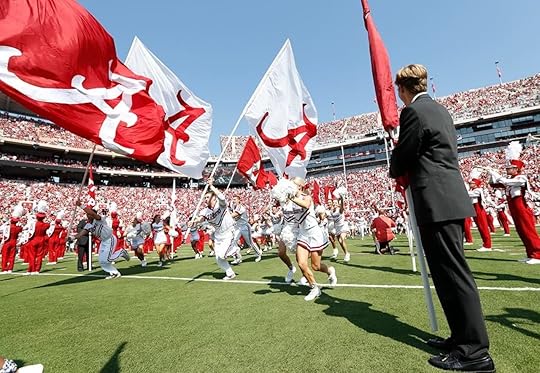
Photo: University of Alabama Athletics/Facebook
University of Tennessee in Knoxville: Bud Light
University of Georgia in Athens: Guinness
Texas A&M University in College Station: Cycle Brewing Rare DOS
University of Florida in Gainesville: Corona Light
University of Missouri in Columbia: Saranac Brewery IPA
University of Alabama in Tuscaloosa: Guinness
University of Arkansas in Fayetteville: Capital Brewing Co. Trail Pale Ale
Independent

Photo: Jeremy R. Smith Sr./Shutterstock
University of Notre Dame in Notre Dame, Indiana: Miller Lite
Brigham Young University in Provo, Utah: Bud Light 

More like this: 17 of the world’s best cities for craft beer
The post The most popular beer in college football towns across the US appeared first on Matador Network.

Book a flight to the ISS

For the low, low price of $55 million, you can travel to the International Space Station without having to become an astronaut. Axiom Space, a company that manufactures space stations, has partnered with Roman & Erica Inc., a New York travel firm, to offer travelers the rare opportunity to visit the International Space Station for 10 days. The program, which begins in 2020, is managed by Mike Suffredini, the former director of NASA’s ISS operation.
The price includes a training camp, round-trip transport to the station on a SpaceX rocket, and a 10-day stay on the space station itself in habitation modules, designed with 24-inch windows for the best view of the Earth.

Photo: Axiom Space/Facebook
Training will take the form of a 15-week program spread out over two years, and be conducted by actual astronauts. It will include basic safety training, how to adapt to weightlessness, bathroom usage, how to operate systems on board Axiom and the ISS, and launch and landing procedures.
Roman Chiporukha, co-founder of Roman & Erica Inc., said in a statement, “Our clients will be the travel pioneers of this generation…this unexplored terrain holds infinite possibilities for the consumer to experience.”
The upcoming Axiom Space Station is slated to eventually replace the International Space Station when it’s officially retired in 2025. 
H/T: AFAR

More like this: 6 space travel projects that will become a reality in our lifetime
The post You can now book a 10-day trip to the International Space Station appeared first on Matador Network.

Best LGBTQ group travel tours

Do you ever find yourself thinking in terms of “either/or”? You either take risks, or you play it safe. You either travel alone or never get a moment to yourself. You’re either off the beaten path or a lame tourist. A lot of people think in terms of black and white, but there are travel experiences out there that take these extreme dichotomies and create a hybrid adventure.
Going on an LGBTQ group tour is a great example of mixing and matching the best of both worlds. You get to be a solo traveler, without having to be completely alone. You get to discover an unknown destination, while still being surrounded by community. You can push yourself outside of your comfort zone, without actually putting yourself in danger. Admittedly, group tours have a reputation for being a little stale or old fashioned, but there’s a new generation of experiences on offer. Here are 10 LGBTQ group tours that are definitely worth signing up for.
1. Trek all the way to Everest Base Camp in Nepal.

Photo: Out Adventures/Facebook
This is a serious outdoor adventure. Training beforehand is a good idea, and you’ll need excellent hiking boots. While on the trek, you’ll be staying in rustic tea houses, some of which don’t have running water. Hiking through the Himalayas is best served unplugged, so you’re advised to leave your laptop at home.
The Tour: Nepal: Kathmandu & Everest Base Camp
Operator: OUT Adventures is a queer-owned tour company and travel brand with a keen interest in responsible tourism.
Duration: 17 days/16 nights
Trip highlight: You get to visit Nepal’s ancient capital, Kathmandu; fly over the Himalayas; and hike to Everest Base Camp (5,364 meters high), gracing “the same trails where many of the mountain’s epic ascents begin.”
2. Snorkel around the volcanic cliffs of Santorini.

Photo: Ivan Mateev/Shutterstock
With the tagline “a day fit for a Greek god,” it’s clear that this tour isn’t angling to be an adrenaline rush, but rather a quietly glamorous day of exploring the Greek island of Santorini from the sea. There’s mention of a private bay and gourmet meals, so if you’re more of the glamping type, then this just might be up your alley.
The Tour: Semi-Private Catamaran Cruise in Santorini
Operator: OUTstanding Travel is a queer-owned travel company that focuses specifically on creating gay travel experiences in Israel, Greece, and Italy.
Duration: Day tour
Trip highlight: Snorkelling, hot springs, and towering volcanic cliffs
3. Bungee jump off the Victoria Falls Bridge.

Photo: kavram/Shutterstock
The Victoria Falls tour is actually offered as an add-on to the 12 Days in South Africa tour, but can presumably be booked on its own. Since Detours integrates a certain amount of customizability into its travel experiences, you could either go full-blown glamazon on this one (after all, you’ll be staying at a four-star boutique lodge, and there’s a luxury cruise down the Zambezi in the cards too), or you could inject some high adrenaline adventure into the mix.
The Tour: Victoria Falls
Operator: Detours is a laid-back gay adventure travel company. Founded by family and run by friends, its tours move away from “cookie cutter” daily itineraries.
Duration: 4 days/3 nights
Trip highlight: Choose from bungee jumping from the Victoria Falls Bridge, swinging through the gorge on the gorge swing, white-water rafting down the Zambezi River, or taking in the view of Mosi-oa-Tunya (“The Smoke that Thunders”) on a helicopter ride.
4. Hop on a quad bike and explore Gran Canaria.

Photo: Jacob Lund/Shutterstock
The Quad Adventure is short, but it’s intense. Most of that time will be spent off-road, exploring the ravines and caves of Gran Canaria, the third biggest of the Canary Islands. If you don’t know how to drive a quad, the guides can teach you; they’ll also you how to drive respectfully through the environment, so rest assured — you won’t simply be ploughing through the wilderness.
The Tour: Quad Adventure
Operator: Rainbow Gay Tours offers group tours led by queer guides in some of Europe’s most gay-friendly cities, including Barcelona, London, Berlin, Lisbon, and Gran Canaria.
Duration: An hour and a half
Trip highlight: You get to drive an ATV Kawasaki 300 Quad (and have the whole thing filmed on a GoPro).
5. Dine with robots in Tokyo.

Photo: Robot Restaurant【ロボットレストラン】/Facebook
Okay, I’ll admit, this one is kind of the wild card in the pack, but you get a front row seat to what can only be described as a when-in-Japan experience — a robot entertainment show (with popcorn included). Plus, you get to visit Shinjuku Ni-Chome, Toyko’s gay hub (home to the world’s highest concentration of gay bars), where you’ll have a drink with your gay or gay-friendly tour guide.
The Tour: Robot Restaurant & gay evening tour
Operator: Out Asia Travel is somewhat enigmatic. The company is based in Japan and “offers a variety of tour packages in Asia for LGBT travelers from all over the world.”
Duration: Four hours
Trip highlight: ROBOTS!
6. Zipline and bridge swing your way across New Zealand.

Photo: Bildagentur Zoonar GmbH/Shutterstock
This tour is a North-to-South, comprehensive exploration of New Zealand with an earthy, wholesome feel. You’ll learn about traditional and medicinal Maori uses for native plants on walks through native bush, discover springs and bubbling geysers, visit galleries, and see what a night sky looks like from the middle of an international dark sky reserve.
The Tour: New Zealand Highlights and Hot Spots
Operator: New Zealand Awaits is a lesbian-owned and operated company. Its focus is on transformative travel, coupled with environmental and social sustainability.
Duration: 13 days/12 nights
Trip highlight: To balance out all the natural serenity, you can pick from a wide selection of high adventure add-ons such as ziplining, taking a flight over an active volcano, a glacier hike, paragliding, and jet boating into a wilderness environment.
7. Sit in on a sumo wrestler’s training session in Japan.

Photo: Meeh/Shutterstock
This tour is all about cultural submersion. The itinerary is a carefully crafted journey through Japan’s history, including World Heritage sites, sleeping on futons, wandering through rock gardens, and learning about the Edo period (Japan’s golden age), only to lead you back to its futuristic present.
The Tour: Essential Japan
Operator: Go!GayJAPAN seems to be the fruit of one Spaniard’s love affair with the Land of the Rising Sun. Founder and guide Oscar López uses his tour company as the perfect excuse to stay connected to Japan.
Duration: 12 days/11 nights
Trip highlight: An overnight stay at a Buddhist temple, dinner served by real geishas, a day trip to Mount Fuji, and a private viewing of a sumo wrestler training session where you get to feel the floor beneath you shake.
8. Fly over the Alaskan wilderness in a helicopter and land on a glacier.
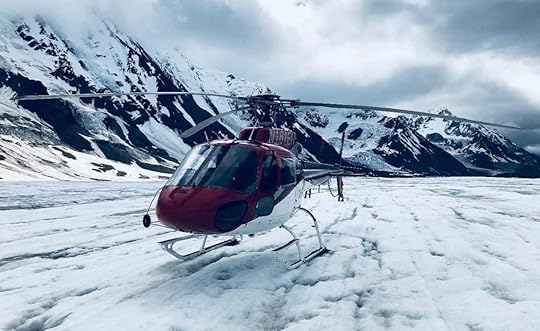
Photo: Stampede Excursions
They call this the heli-hike tour, so while you’ll definitely get a lot of bird’s-eye views from the helicopter, you’ll also get a chance to step out into the tundra with a naturalist guide. The helicopter takes off and leaves you there, free to explore and go as far as you like, and then it’ll come and find you wherever you end up. Depending on the season, you might end up exploring icefalls, massive crevasses, and ice pools.
The Tour: Denali Glacier Landing
Operator: Stampede Excursions is a queer-owned and operated Alaskan tour operator based in Denali National Park.
Duration: Two hours
Trip highlight: You get to see the landscapes that lured Christopher McCandless to Alaska from the air, and then get a little lost in the wilderness for a while.
9. Swim with whale sharks in the waters of Isla Mujeres.

Photo: Chainarong Phrammanee/Shutterstock
This tour is really about one thing and one thing only — maximizing your time in the water with whale sharks. Two out of the five days you’ll spend on the island will be spent off the coast snorkeling in the Caribbean Sea with whale sharks and manta rays. The rest of your time is very much yours to do with as you please.
The Tour: Swimming with Whale Sharks
Operator: Reefs to Rockies is a queer-owned travel tour duo that focuses on providing outdoor experiences in the world’s wildlife and birding hotspots. Co-founders Lynda and Sheridan have a strong green streak and have donated more than one percent of their gross sales to conservation and environmental education organizations.
Duration: 5 days/4 nights
Trip highlight: Swimming with whale sharks and visiting a turtle nursery
10. Join a Gay Surf Camp in the Canary Islands.

Photo: Spain Seven Degrees/Facebook
This experience will give you a solid week’s worth of getting out there in the waves. Its structure and format balances the rhythm and discipline needed to get practice, gives you a lot of time to recover, and also allows you to experience more than just Gran Canaria’s consistently warm waters. While the only LGBTQ aspect of some tours is the clientele they aim to attract, the Gay Surf Camp includes a guided gay nightlife tour, a viewing of a gay surfer documentary, and a drag show finale.
The Tour: Gay Surf Camp
Operator: Spain Seven Degrees is a small team of four, who share solid travel credentials and the joint mission of creating gay tours in Spain that are good for the body and soul.
Duration: 8 days/7 nights
Trip highlight: At least 15 solid hours of surfing, plus a little whale watching, and optional yoga for good measure
Keep in mind that these aren’t the only tours run by these operators. Be sure to browse their websites to check out the full scope of what they have to offer. 

More like this: The best resources for LGBTQ+ travelers to have on hand
The post 10 epic group tours for LGBTQ travelers appeared first on Matador Network.

Oldest intact shipwreck found

The Titanic might be among the world’s most famous sunken ships, but it certainly isn’t the oldest shipwreck out there. This distinction is reserved for the ship that scientists have recently discovered off the coast of Bulgaria.
Found at the bottom of the Black Sea, the 75-foot ship is believed to date back to 400 BC and be the world’s oldest intact shipwreck. It is considered to have functioned as a Greek trading vessel, which, until now, had only been seen on the sides of ancient Greek pottery such as such as the “Siren Vase” in the British Museum. Surprisingly, its mast, rudders, and rowing benches are all intact, probably preserved by the lack of oxygen at the 1.25-mile depth it was under.
Professor Jon Adams, principal investigator with the Black Sea Maritime Archaeology Project, said, “A ship surviving intact from the classical world…is something I would never have believed possible. This will change our understanding of shipbuilding and seafaring in the ancient world.”
For the past three years, maritime archaeologists, scientists, and marine surveyors have been on a mission to explore the Black Sea to gather data on prehistoric sea-level changes. This ship is one of over 60 wrecks that have been discovered in the process. The rest vary in age, from a 17th-century Cossack fleet to Roman trading vessels.
Although the research team intends to leave the Greek vessel in place, a small piece has been taken and used for carbon dating, which confirms that it is, in fact, the oldest shipwreck currently known to humankind. More detailed data will be published at the Black Sea MAP (Maritime Archeology Project) conference in London later this week. 
H/T: The Boston Globe

More like this: 11 African ruins you need to see besides the Pyramids
The post The world’s oldest shipwreck was just discovered in the Black Sea appeared first on Matador Network.

Smelly fruit caused plane boycott

A passenger’s B.O. can make a flight unbearable, so imagine how bad it must be to have two tons of the world’s smelliest fruit stink up an aircraft cabin. On Monday, a Sriwijaya Air flight from Bengkulu to Jakarta was grounded when passengers refused to stay in the airplane due to an overwhelmingly bad stench. The famously stinky durian, a fruit whose smell is best described by food writer Richard Sterling as “turpentine and onions, garnished with a gym sock,” was enough to cause a massive passenger boycott, until the airline relented and unloaded the offending cargo. The flight departed about an hour after its scheduled takeoff time.
“It’s not illegal to carry durian in a flight,” said a Sriwijaya Air spokesperson in a statement, “so long as it’s wrapped properly in accordance with flight regulations — carried inside the hold,” but the airline did promise to investigate other ways of transporting the fruit in the future.
Not everyone is repulsed by the scent, however. Anthony Bourdain once said the fruit was “indescribable, something you will either love or despise.” He did, however, add that “your breath will smell as if you’d been French-kissing your dead grandmother” after eating it.
Some countries have actually taken steps to ban the transport of durians. In Singapore, it’s not allowed to be taken on the subway, and in Thailand, Japan, and Hong Kong, “no durian allowed” signs are common outside of buildings such as hotels. 
H/T: Travel & Leisure

More like this: The 9 weirdest fruits in the world and where to try them
The post A cargo of stinky durian grounded a plane in Indonesia appeared first on Matador Network.

Festivals where you can throw stuff

Everyone enjoys music festivals , New Year’s Eve celebrations, and traditional parades, but there’s one problem with those traditional events — you don’t get to throw stuff at people. Sure, you can throw beads during Mardi Gras, but that’s nothing compared to the unbridled mayhem of the festivals where the whole point is to pelt fellow participants with a variety of messy substances. From a food fight with oranges in Italy to tomatoes in Spain, here are seven of the craziest festivals around the world where people throw things at each other.
1. La Tomatina — Buñol, Spain

Photo: Iakov Filimonov/Shutterstock
Every year on the last Wednesday in August, thousands of people gather in the town of Buñol in Spain to throw squashed tomatoes at each other. Rumors says that La Tomatina began in 1944, when children threw tomatoes at a bad musician and the situation quickly escalated into a food fight, but no one is quite sure how the annual event really began. What we know is that it’s one of the most fun celebrations anywhere in the world, but if the festival itself is not enough excitement for you, there’s also a party at a nearby club before and after the event.
2. Songkran Festival — Thailand
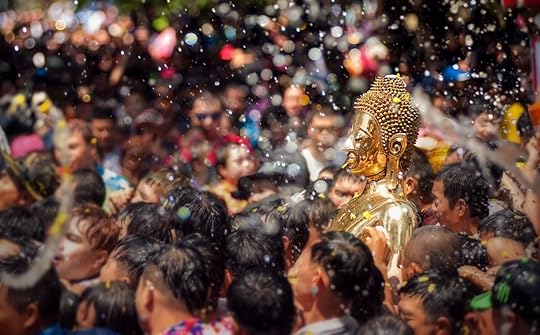
Photo: Suriya99/Shutterstock
If you’re looking for an excuse to return to the summers of your youth, and play with water balloons and Super Soakers, then you need to get yourself to Thailand between April 13th-15th. At the Songkran Festival, mainly taking place in Chiang Mai, Bangkok, and Phuket, people take to the streets to soak each other with water guns, hoses, and buckets. The festival is rooted in Buddhist tradition, which says that water has purifying properties, and can wash away evil spirits.
3. The Battle of the Oranges — Ivrea, Italy

Photo: Paolo Bona/Shutterstock
Ivrea is a small town in northwest Italy that gathers over a million pounds of oranges each year for its annual Battle of the Oranges. The battle is made up of squads of orange throwers on foot and groups in carts defending their vehicles from the throwers. In total, there are around 4,000 total competitors who spend the day hurling oranges at each other and have been doing so since 1808. The event commemorates the revolt of the people of Ivrea (the orange throwers) against the tyranny of the Royal Napoleonic Troops (the people in the carts), after hated despot Raineri di Biandrate got killed by a miller’s daughter who refused the jus primae noctis. The battle will take place on March 2nd-5th, 2019, and if you don’t feel like taking an orange to the face, you can always just choose to be a spectator (or wear a mask).
4. Haro Wine Festival — La Rioja, Spain

Photo: Iakov Filimonov/Shutterstock
The Haro Wine Festival in La Rioja sees hundreds of people, equipped with leather satchels filled with red wine, climb a mountain to pour it all over each other. The celebration dates back 400 years to a battle in the 13th century, when the Haro and Miranda de Ebro regions fought over their borders. Originally Haro celebrated its victory with a red wine toast, but it’s now evolved into a wine fight. The event takes place every June 29th at 7:00 AM, and we can’t really imagine a better way to start the day. The festival’s website describes the event as “the biggest party that the quaint town of Haro sees,” and when the wine dousing is done, the day is capped off by traditional dancing on the streets below the mountain.
5. Holi — India
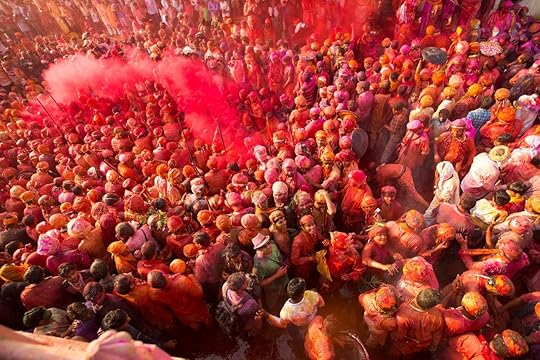
Photo: SatpalSingh/Shutterstock
Perhaps one of the most fun and vibrant celebrations in the world, Holi is called the Festival of Colors for good reason. This year it’s from March 20th to 21st, 2019, and on the second day of Holi, participants converge in massive numbers all across India to cover each other with bright, powdered dye. According to National Geographic, this tradition is rooted in Hindu deity Krishna’s jealousy over his sister Radha’s fair skin (Krishna is quite blue). When Krishna complained to his mother Yashoda about this injustice, she supposedly replied that Krishna may paint his sister’s face whatever color he wished. The colors used during Holi carry meaning; red dye symbolizes love, fertility, and matrimony, while blue represents Krishna.
6. World Custard Pie Championship — Coxheath, England
View this post on InstagramA post shared by Rob Faulkner (@thatguyinatutu) on Jun 26, 2018 at 8:36am PDT
While many might see this festival as a tragic waste of dessert, the British seem to revel in the opportunity to throw pies at their fellow countrymen. Originally conceived as a way of raising funds for the village hall nearly 50 years ago, the competition now attracts participants from around the world. Players are divided into teams of four, with judges awarding points to those who strike their opponents directly in the face. While fancy dress is optional, it’s customary to dress either in Victorian garb or futuristic outfits. Taking place in the village of Coxheath, the event has been held annually since 1967. It’s estimated that a staggering 3,000 pies are thrown each year.
7. Setsubun Bean-Throwing Festival — Japan
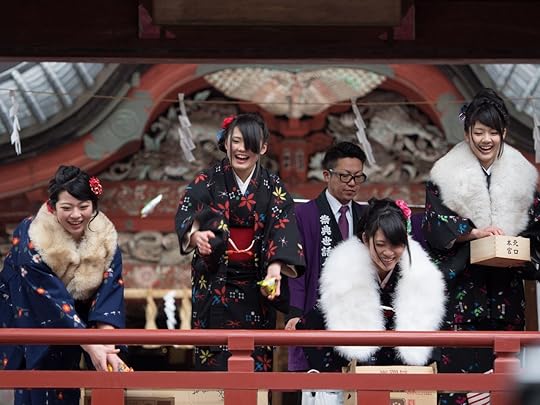
Photo: mcnegative/Shutterstock
This Japanese festival traditionally marks the beginning of spring, though it has nothing to do with cherry blossoms. On February 3rd, people all over Japan will take roasted soybeans, and either throw them out the window or at members of their family dressed as demons. Since beans are thought to represent vitality and purity, the bean-throwing is believed to cleanse the evil of the previous year, and mark the start of a fresh Lunar New Year. The tradition began back in the 14th century, and it’s still a favorite, especially with children. 

More like this: 7 cultural festivals you need to check out around the world
The post 7 crazy festivals where you get to throw stuff at people appeared first on Matador Network.

The most popular destinations for US travelers this Thanksgiving

While Thanksgiving is traditionally a time to be spent with friends and family during the fall, that doesn’t mean you have to spend it in the cold. Maybe the reason family Thanksgiving dinners are so argument-prone is because you’re crammed into someone’s stuffy dining room instead of lounging on the beach.
A study conducted by CheapOair, a flight-focused travel agency, found that those who are choosing to remain in the country this Thanksgiving (74 percent of the total people traveling during the holiday) seem to be looking for a break from the winter weather. The top 10 destinations (and the average round-trip airfare) this Thanksgiving are:
New York, NY ($352)
Orlando, FL ($306)
Los Angeles, CA ($348)
Las Vegas, NV ($305)
Miami, FL ($351)
Ft. Lauderdale, FL ($317)
Denver, CO ($312)
San Francisco, CA ($370)
Dallas, TX ($346)
Atlanta, GA ($287)
This Thanksgiving, 26 percent of the 30 million people traveling during the holiday are heading abroad, an increase of six percent compared to previous years. The most popular destinations (and the average round-trip airfare) for those leaving the country rank as follows:
London, England ($717)
Cancun, Mexico ($473)
Paris, France ($570)
Tokyo, Japan ($984)
Mexico City, Mexico ($350)
Bangkok, Thailand ($773)
Dublin, Ireland ($614)
Barcelona, Spain ($647)
Hong Kong ($852)
Amsterdam, The Netherlands ($573)
Tom Spagnola, CheapOair’s senior vice president of supplier relations, said in an email, “While the tendency is still to stay local for Thanksgiving, more consumers are feeling the urge to spend the holidays somewhere unfamiliar and exotic.” He added that top international travel destinations have dropped their prices by an average of 14 percent this year, further incentivizing people to celebrate Thanksgiving abroad. 

More like this: Where to go this Thanksgiving instead of going home
The post The most popular destinations for US travelers this Thanksgiving appeared first on Matador Network.

November 7, 2018
Delta passenger steps in dog feces

While flight crews are trained to offer impeccable customer service, that doesn’t mean there isn’t the occasional lapse. One such lapse was recently on display on a Delta Airlines flight from Atlanta to Miami this past Thursday. When boarding the aircraft, a passenger stepped in dog feces, and when he alerted the flight crew, they were indifferent at best. “It was feces,” the passenger, Matthew Meehan, told WSB-TV 2 Atlanta, “and it was everywhere. It was on my seat. It was on the floor. My feet were in it.”
When Meehan told the flight crew about the incident, he didn’t receive the response he expected. According to him they simply handed him two paper towels and a little bottle of Bombay Sapphire. Even worse, when the issue was raised to the Delta customer service manager, she said, “Well, that’s not my problem… if the cleaning crew didn’t clean your seat, I don’t have any control over that.” Understandably, Meehan couldn’t believe Delta’s handling of the situation. “I have never in my entire life felt more dehumanized,” he said. “I felt like an animal.”
In a statement to Business Insider, Delta apologized to all passengers affected and offered full flight refunds. “We are conducting a full investigation while following up with the right teams to prevent this from happening again,” they said. The statement also confirmed that passengers had begun boarding the aircraft before cleaning crews had finished their work, and that the previous flight had an “ill service animal” on board. 
H/T: Travel & Leisure

More like this: 7 rights all air passengers have and should know about
The post A Delta passenger stepped in dog feces, and flight attendants told him to clean it himself appeared first on Matador Network.

The best US national parks in winter
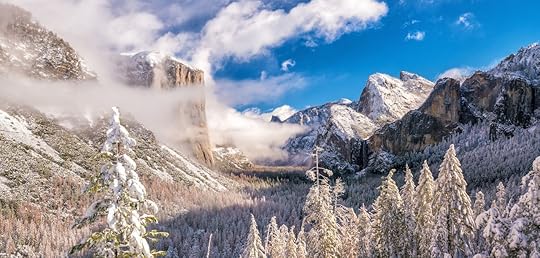
Winter may not seem like the ideal time to visit the wilds of a national park, but really there’s no bad time to enjoy the beauty of America’s public lands. Some national parks situated in temperate, even tropical climates are better to visit in winter, free from the scalding heat of summer. If you’re a snow bunny, you’ll enjoy relative quiet in some of the larger parks that are visited en masse during warmer months. No matter your preference, you’ve got plenty of choices. From Hawaii to Utah, here are the best national parks to visit this winter.
1. Bryce Canyon National Park, Utah

Photo: Songquan Deng/Shutterstock
Winter brings a lull in the crowds visiting this popular southern Utah park. Running along a high plateau at the top of Grand Staircase, a series of high-desert mesas, Bryce Canyon’s high altitude (8,000 to 9,000 feet) almost guarantees light, dry snow and crisp, clean air. You can slide through the park’s famous red rock hoodoos — the largest concentration on Earth — on cross-country skis or snowshoes. If you don’t have snowshoes of your own, the park offers them for free if you join rangers for a guided hike.
From November to March, the park’s full moon snowshoe hike is an excellent option. Rangers guide you through the deep snow to locations offering the best views of the full moon filling up the dark sky, with the hoodoos looking eerie in the moonlight. A limited number of campgrounds and RV spots within the park are available during winter; you can reserve at the Visitor’s Center.
2. Everglades/Biscayne National Parks, Florida

Photo: Kyle T Perry/Shutterstock
Some consider the Everglades a murky, dangerous wilderness, but it’s actually the largest subtropical rainforest in the United States, not to mention a World Heritage Site, International Biosphere Reserve, and Wetland of International Importance. Winter is a great time to dive into all that Everglades and Biscayne parks have to offer — without the sweltering heat and bugs of summer. Everglades is the third-largest national park in the continental US, and its 2,400 square miles offer everything from kayaking through mangroves and multi-day canoe trips to missile base tours and “slough slogs.”
Wildlife watching is one of the most popular activities here, and you can expect to see manatees, dolphins, crocodiles, alligators, turtles, and herons to name a few. You can camp year-round throughout the park and in the backcountry on the 99-mile Wilderness Waterway. Just a few miles to the east of the Everglades sits Biscayne National Park, which is a great spot for water lovers. Its beaches, blue waters, and coral reefs can be explored by foot, boat, and while snorkeling. These are two great winter escapes in one place.
3. Yosemite National Park, California

Photo: f11photo/Shutterstock
Famed naturalist John Muir called this jewel of the national park system “by far the grandest of all the special temples of Nature I was ever permitted to enter.” First protected in 1864, Yosemite National Park is best known for its waterfalls, hiking, rock climbing, and scenic vistas made famous by photographers such as Ansel Adams. Though winter isn’t the greatest time to scale some of Yosemite’s better-known attractions, Half Dome or El Capitan, it is an ideal time to enjoy the beauty of the park without the other thing it’s known for: crowds.
While some roads close in winter, Glacier Point Road is among those that stay open. Five miles in, it closes to cars at Badger Pass and transforms into the Yosemite Ski & Snowboard Area. Yosemite Valley also remains open, allowing hikers and snowshoers to experience iconic sights such as Bridalveil Falls, Mirror Lake, and Lower Yosemite Falls. Another popular snowshoeing option is through one of the park’s ancient sequoia groves. Lodging is also much easier to find in and around the park in winter. You’re likely to find comfortable digs in the park’s grand Majestic Yosemite Lodge, or if you’re into roughing it, you can bed down at one of the four campgrounds open year-round.
4. Great Smoky Mountains National Park, Tennessee/North Carolina

Photo: Robert Bohrer/Shutterstock
As rich in history as it is wildlife, Great Smoky Mountains Park is a perfect place to while away short winter days. Thanks to its temperate location, snuggled in the rolling hills shared by Tennessee and North Carolina, the park has year-round wildflowers and rich wildlife-viewing opportunities. You might spot black bears, white-tailed deer, coyotes, groundhogs, wild turkeys, raccoons, or skunks — or you can fish in the rivers, streams, and lakes. Five drive-in horse camps provide access to the 550 miles of hiking trails open to horses. History fans will be awed by the park’s more than 150 historic cemeteries, and a walk amongst the headstones provides special insight into the communities that once called the area home. You can camp year-round with Cades Cove being one of the most popular campgrounds.
5. Rocky Mountain National Park, Colorado
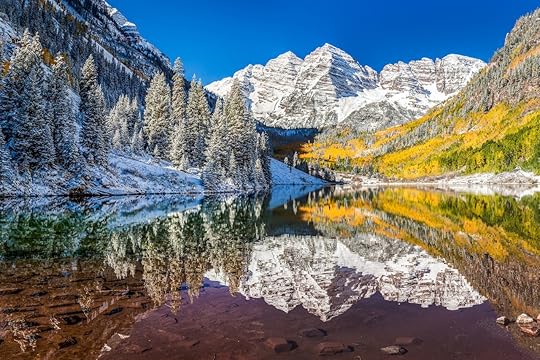
Photo: kan_khampanya/Shutterstock
If you like playing in the snow, this is the spot to be in winter. Rocky Mountain National Park spans 415 square miles of spectacular mountain environments — from subalpine to alpine. You can cross-country ski throughout the park, as well as snowshoe. Beginning in January, park rangers host regular snowshoe tours, which are a great way to get familiar with the craggy surroundings. Sledding and ice skating are popular at Hidden Valley, a former ski area. Rocky Mountain National Park is also one of the country’s top wildlife viewing destinations, and that’s the number one rated activity by a majority of the park’s 3,000,000 annual visitors.
The biggest draw is its big mammals, and in winter, you can spot massive herds of elk, bighorn sheep, and mule deer with a few moose sprinkled in. While Moraine Park Campground is open for overnights, a more comfortable option may be heading into one of the nearby towns of Estes Park or Grand Lake for a warm bed and a famous Colorado microbrew in front of a roaring fire.
6. Big Bend National Park, Texas
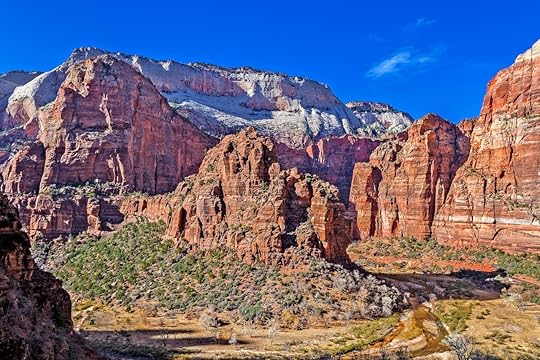
Photo: randy andy/Shutterstock
One of the largest national parks in the continental US, Big Bend is also one of the most remote. The closest large city, El Paso, is a 5.5-hour drive, meaning that crowds in the park aren’t much of a problem. What can be an issue, though, is the heat, which is why visiting Big Bend in winter is ideal. Temperatures in December average 70 degrees during the day and 50 degrees at night. It’s dream camping weather, and though the park has more than 200 campsites to choose from, choice locations can fill up quickly.
Big Bend has more types of birds, bats and cacti than any other national park, and there are countless hiking options to enjoy them within its 801,163 acres. Winter is also a good time to float down the Rio Grande by canoe, which can be done independently or with a professional guide service. If you’ve got a passport on hand, a $5 row boat ride ferries folks across the river to the Mexican town of Boquillas. It’s a prime place to spend a winter’s day eating hot enchiladas, drinking a cold margarita, and maybe taking a warming dip in the town’s funky hot springs.
7. Haleakala National Park, Maui, Hawaii

Photo: Vlue/Shutterstock
For those heading to the islands, a visit to Maui’s Haleakala National Park is worth the effort to get there. Meaning “house of the sun” in Hawaiian, Haleakala is actually a huge domed volcano that covers three-quarters of the island. Visiting this national park is among the most popular things to do to on Maui, especially in time to watch the sunrise from atop the volcano. Mark Twain described sunrise from atop Haleakala as “the most sublime spectacle I have ever witnessed.” Apparently, many agree. If you want to jostle with the crowds for the perfect photo of the dawning of a new day, book with a local tour company or be prepared to obtain a permit in advance as parking space at 10,023 feet is limited.
Another option is to head up the mountain to experience a famed Hawaiian sunset. Permits are not needed, and it allows for a day of exploring the park’s other beautiful sights, from otherworldly deserts of rock to lush Hawaiian rainforest. You’ll spot nenes here, Hawaii’s state bird and an endangered species. Haleakala National Park actually protects more endangered species than any other park in the National Park Service. You can camp or stay in cabins in the park and, for complete immersion, it’s a great thing to do in the winter.
8. Carlsbad Caverns National Park, New Mexico
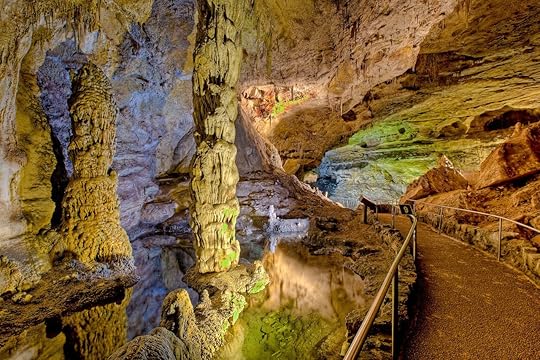
Photo: Doug Meek/Shutterstock
Actor Will Rogers once called Carlsbad Caverns “the Grand Canyon with a roof over it.” It’s an apt descriptor, and the park attracts nearly 500,000 people a year — most of them in the summer. Winter is the perfect time to skirt the crowds and quietly appreciate the beauty of this unusual spot. Over 119 caves are hidden beneath the Chihuahuan Desert, all formed when sulfuric acid dissolved the limestone remnants of an ancient fossil reef.
If you arrive just as the park opens, you may find yourself the only one meandering down the 1.25-mile, 750-foot-deep Natural Entrance Trail into the mouth of the caverns. Inside, the Big Room is an alien-looking limestone chamber almost 4,000-feet long, 625-feet wide, and 255-feet high — the fifth-largest chamber in North America. Above ground, the desert is alive with flowering cacti, wildlife, and rocky canyons prime for hiking. You can’t camp at Carlsbad Caverns, but if you’re adventurous, you can boondock on neighboring Bureau of Land Management land. For more comfort, the town of Carlsbad has plenty of hotels, and year-round camping is available at “sister park” Guadalupe Mountains National Park, which is 40 minutes away in scenic west Texas.
9. Hot Springs National Park, Arkansas
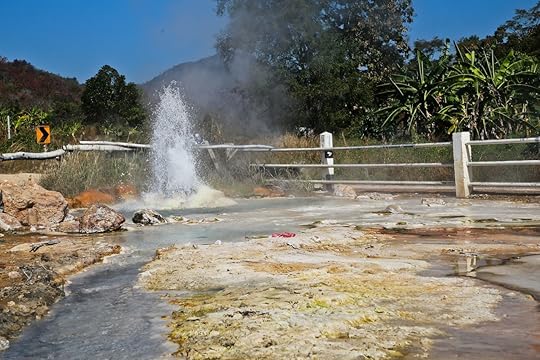
Photo: noppawan leecharoenphong/Shutterstock
Hot Springs, Arkansas, has been called the “Calistoga of the South,” and it’s easy to understand why: The entire north end of the city is a national park built around hot springs. For years, people have been flocking to this town to take advantage of the much-touted health benefits of its bubbling thermal mineral waters. Winter is an ideal time to soak in the warmth. Hot Springs National Park’s visitor center is located in the historic, stained-glass-and-marble Fordyce Bathhouse, which sits on the city’s Bathhouse Row. Visitors can opt for a hot soak in a traditional bath at the Buckstaff Bathhouse, which has been in business since 1912 or opt for a more modern spa experience at Quapaw Baths and Spa.
After you get thoroughly pruned, walk around the city to check out the stylish Art Deco buildings. If you’re looking for more of a challenge, miles of trails run through the park. The longest and most popular path is the Sunset Trail, which covers more than 10 miles and crosses the varied terrain of the Ouachita Mountains. Since Hot Springs National Park is located in an actual city, you’ll find plenty of places to rest your heads. If you want to sleep under the stars, Gulpha Gorge Campground is open year-round. 

More like this: 15 US state parks that are just as epic as national parks
The post The best national parks to visit this winter appeared first on Matador Network.

Matador Network's Blog
- Matador Network's profile
- 6 followers



